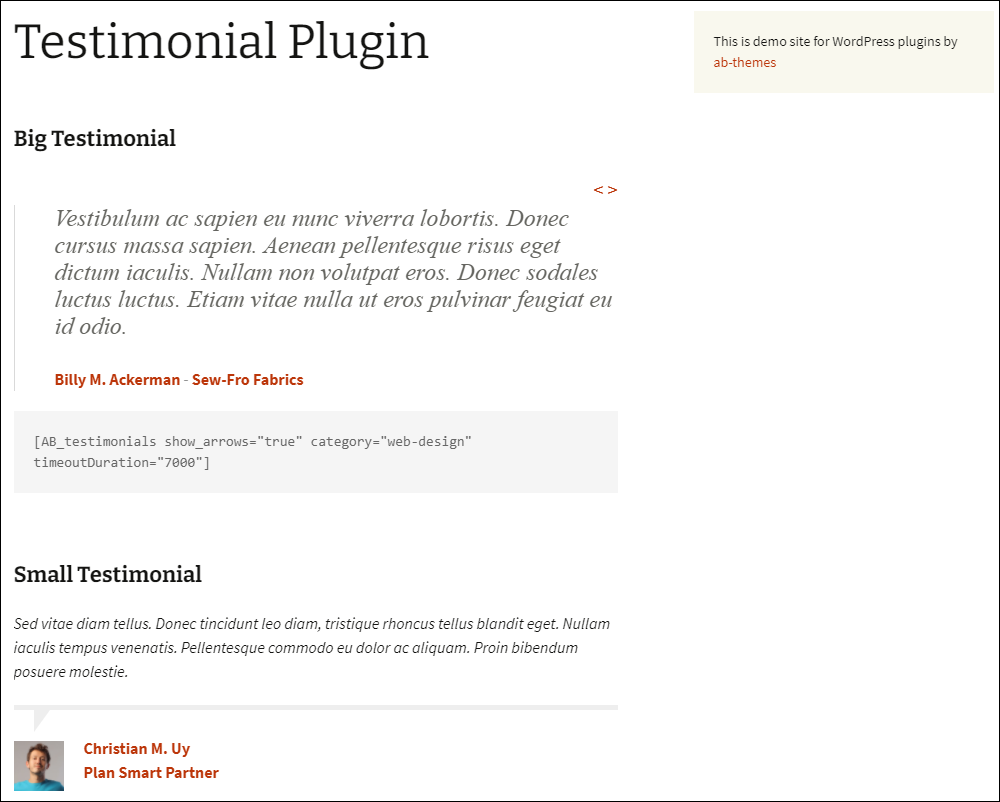Content Marketing With WordPress – Testimonials And User Reviews

This tutorial is part of our series on using content marketing to create more exposure online for your business and drive more traffic to your site.
Subscribe to our web content creation course and learn how to never run out of great content for your website, blog, or newsletter.
***
If you’re trying different marketing strategies to attract and retain new customers but getting the same disappointing results, this tutorial may just help you achieve the breakthrough you are looking for.
Most businesses don’t need to be told that finding effective and profitable ways to generate new customers is hard, expensive, and time-consuming.
In today’s digital, social media-driven economy, businesses just can’t afford to ignore online consumer behavior, especially if they are posting negative comments about your business.

You could also be doing your business a great disservice if you are not promoting all the positive things your customers and clients are saying about your products, services, support, training, etc.
Testimonials, user reviews, and case studies are powerful, persuasive, and effective ways of marketing and should be an integral part of your content marketing.
In this tutorial, you’ll learn how to create better results online using compelling and engaging customer reviews and testimonials.
The Power Of Using Customer Reviews And Testimonials
Phineas Taylor (Aka “P.T.”) Barnum, the legendary American showman and businessman, is often quoted as having said that “Nothing draws a crowd quite like a crowd.”
P.T. Barnum obviously understood the power of “social proof”. Social proof-driven content is a powerful way of getting your business promoted effectively.
Quoting genuine reviews and testimonials from happy customers is a far more persuasive way to attract new customers than anything you can say about your own products or services.
When used correctly, reviews and testimonials are a great source of building credibility and creating new opportunities to generate new business.
Research and studies conducted by many leading marketing companies all lead to the same conclusion: adding consumer reviews and testimonials to your site helps to reduce or eliminate many doubts, concerns, and objections your prospects may have about purchasing your products or service and helps to increase sales conversions.
Here are just some of the findings that support this:
- According to a study by eVoc Insights, a company that researches and measures user experience, “In general, 63% of users indicate they are more likely to purchase from a site|web site if it has ratings and user reviews.”
- According to Reevoo.com, user reviews result in an average 18% uplift in sales and 50 or more reviews per product can translate into a 4.6% increase in conversion rates.
- Website visitors that interact with both user reviews and customer questions and answers are 105% more likely to purchase while visiting and spend 11% more than visitors who don’t interact with user-generated content (UGC). (Bazaarvoice, Conversation Index, Q2 2011).
- Consumer reviews are significantly more trusted (nearly 12 times more) than descriptions that come from manufacturers, according to a survey of US internet users by online video review site EXPO. (eMarketer, February 2010).
(Source: eConsultancy.com)
Adding User Reviews And Testimonials – Managing Online Reputation
Clearly, you should be adding positive reviews and testimonials from happy customers to your website, especially anyone who is delighted or thrilled with the results they’ve obtained using your products or services. Building a solid reputation online is essential for the growth and success of your business.
User reviews, however, are like double-edged swords; they can impact your business both positively and negatively.
Users may not be saying bad things about your business to your face, but they could be posting negative comments and disparaging remarks on social media or discussion forums. This could be about an unpleasant experience they’ve had with your business, like an encounter or dispute they’ve just had with one of your employees or customer support representatives, and this could do far more damage to your business than all the good work you’ve put into building it.
This is where online reputation management becomes vital to your business and why it should be an important part of your content marketing strategy.

Misconceptions about online reputation management practices being too complicated or too time-consuming (or the belief that you don’t need to worry about it) could seriously hurt your business without you even realizing or being aware of this.
![]()
Search for “online reputation management tools” online, or check some of the sites listed below for tools and services that can help you manage user feedback and avoid the escalation of negative reviews about your business:

Improve Your Sales Conversions With Compelling Testimonials
As mentioned earlier, user reviews, testimonials, and case studies are powerful and effective ways to market and promote your business online and should be included in your content marketing strategy.
When you quote responses from your own customers or clients in your content, you are helping potential prospects:
- Identify and understand what challenges and pain points your products, services, or solutions can help to solve, and how it can do this.
- Address and eliminate common objections and concerns.
- Connect with their aspirations, desires, and motivations. This can facilitate the sales process and move them closer to a buying decision.
Here are some useful tips on ways to improve your sales conversions using testimonials:
- Avoid over-editing: Use your customer’s actual words as much as possible. Leaving grammatical or spelling errors in the content helps to keep your testimonials ‘real’.
- Use photos of real people: It’s a proven fact that using images of people’s faces will draw the most attention of visitors browsing your web page. Adding real client photos next to their testimonials and reviews will help to increase visitor engagement with your content.
- Use the power of storytelling: Stories sell far more effectively than simply providing facts and statistics. Being able to present a customer’s horror story and how your solution saved the day will make a far greater and longer-lasting impression on prospects than using generic statements about “providing excellent customer service” and giving “two thumbs up” recommendations that everyone has heard before.
- Keep things in context: Add testimonials to your site only where it makes the most sense to place these, and where you believe they can most effectively help sell your point. For example, think about the impact you can create on your visitor’s perception by adding testimonials from past customers stating how much they enjoyed getting your products for a “bargain” before posting your pricing information. Or testimonials praising you for solving their problems before presenting the benefits of your services, or testimonials where customers are genuinely thrilled with your customer service team before offering a risk-free guarantee and inviting them to purchase from you.
- Quantify your information: Which of the following statements do you think your prospects would find more powerful: “As a direct result of implementing XYZ solution, our sales increased by 150% compared to the previous year,” or “XYZ solution definitely helped us grow our sales”? Whenever possible, ask clients to specify quantifiable results when submitting testimonials, like how much your solution helped to increase their profits, sales, or market share by, what specific percentages or amounts did your solution help to reduce their costs by, how many hours of work they have saved, how many new leads or new clients they were able to generate during a specific period, what kind of things are they able to do or experience now that they couldn’t do before, etc.
- Use different testimonials throughout your site: Although this can be a little difficult when you are just starting out or don’t have many clients yet, try to avoid using the same testimonial everywhere throughout your site. Depending on the nature of your business, you could try to obtain more testimonials by offering limited review copies of your product, or a special launch discount for existing clients in exchange for an honest review and permission to publish it if you decide to use it.
- Appeal to your ideal target audience: As every infomercial featuring a celebrity endorsement, subject expert, or “busy mom” knows, if you know who your ideal customer is, providing testimonials from people who your prospects can relate to (or aspire to become) can be extremely powerful in terms of influence and motivation. People want to buy from “better versions” of themselves, so make sure to include testimonials that speak directly to your target demographic.
- Reprint testimonials across different platforms. If someone publishes great feedback about your business on your Facebook page, send them a message asking for their permission to reprint their comment elsewhere (e.g. your blog or other social media platforms).
- Don’t use fake testimonials. Many people can tell if you are employing copywriters to create your content. Outsourcing content is fine, but prospective clients need to believe that the testimonials on your site are genuine. Don’t compromise your integrity or reputation with “made up” testimonials.
How To Get Client Testimonials
Here are some action steps you can begin to implement immediately to get more testimonials:
Always Ask For Testimonials
Ask for a testimonial as soon as you are done performing a service for a new client, or a customer says they are really happy with your product or service. Getting a testimonial from a happy client can be as simple as just asking for it.
Here are some useful guidelines for soliciting testimonial from clients and customers:
- Make a point of contacting clients after a specific period of time has elapsed since they have purchased or used your service (e.g. 7, 14, or 30 days) and request feedback or a testimonial if you did not obtain one immediately after completing the sale or performing a service.
- Include a field for testimonials in your client satisfaction or follow-up surveys.
- Next time you meet with your client or hand over a completed project, if they are delighted with the results, pull out your phone and ask them if they would be happy to record a quick video testimonial or give feedback. While recording the video, describe to your viewers what you have done for your client and try to capture your client’s positive reactions and genuine feedback and responses.
- Make it easy and write their testimonial. Whenever clients send you positive written feedback (e.g. an email thanking you for a great job well done) containing snippets that would make a useful testimonial, grab the best sections (only use what they have written – never put words into their mouth), and create the testimonial you would like them to provide ou using their own words. Next, contact the client and ask them for permission to publish it on your site. Explain that you have already prepared something to save them time and invite them to edit what you have written however they see fit before giving you their approval to use it. They can always say no, but more often than not, they will probably just say yes, especially if they are delighted with your service or products.
Offer To Post A Link Back To Their Site Wherever You Quote Their Testimonial
Offer to link to their site in exchange for their testimonial. This is a great incentive to get clients to provide you a testimonial. It also makes an implicit statement to your site visitors that your testimonials are real and can be verified.
Include Requests For Testimonial In Your Emails And Newsletters
When emailing subscribers or customers, include a request for a testimonial. If you send out scheduled emails via an auto-responder or newsletter, make sure to include these requests in your signature. Preferably, this should be done as soon as your customers have had a chance to experience and assess the results of using your products or services. Use words like “I need a quick favor” or “I need your help” in your email subject line and specifically ask them to provide honest feedback, a testimonial, or a review.
Use LinkedIn
The LinkedIn “Recommendations” feature is a great way to obtain testimonials from other members. The process of requesting and providing recommendations is quite simple. Anyone who provides a recommendation receives a link to their profile and the testimonial becomes part of your profile. If you get a positive recommendation on LinkedIn, ask for permission to reprint it on your website and other social media platforms. Tip: offer to post a link to their website or profile in exchange.
Create A Testimonials Page On Your Site
Create a page on your website for testimonials and add a “read more testimonials from happy customers…” link to this page wherever you display your testimonials.
![]()
You can measure the effectiveness of testimonials by how long visitors remain on your “Testimonials” page. Using “heatmaps” is a great way to understand and measure visitor behavior on your site.
Testimonial Plugins for WordPress
If your website or blog is powered by WordPress, there are many testimonial plugins you can add to it. Some plugins allow you to add a form to your testimonials page inviting other users to submit their testimonials, feedback, or reviews.
After installing and setting up your testimonials plugin, make sure to provide simple instructions for adding testimonials via the submission form (if available). All you have to do after this is refer new customers or clients to your “Testimonials” page using any of the methods for asking for testimonials discussed earlier.
Here are some great WordPress testimonial plugins you can check out:
Easy Testimonials

Easy Testimonials is a free and easy-to-use WordPress plugin that lets you add testimonials to your sidebar as a widget, or embed them into your posts and pages using a shortcode.
The plugin also lets you add a list of all your testimonials or output a random testimonial, and include images with testimonials, which can be used to add a photo of the testimonial author, or their business logo.
The plugin also offers a “pro” version with additional features and plugin support.
For more information about this plugin, go here: Easy Testimonials – WordPress Testimonials Plugin
Testimonials Widget

Testimonials Widget is a free plugin that lets you randomly slide or list selected portfolios, quotes, reviews, or text with images or videos on your WordPress site. You can insert testimonials into your posts and pages using a shortcode, theme functions, or widgets with category and tag selections and specify different display options such as random or specific ordering.
This plugin offers plenty of additional features via a premium version, including built-in options for improving search engine results and plugin support.
For more information about this plugin, go here: Testimonials Widget
AB Testimonial WordPress Plugin

This premium WordPress testimonials plugin offers a range of useful features right out of the box, including:
- Responsive design that resizes to display correctly on any device or browser.
- Options to display your testimonials in a widget or as slideshows, sliders, grid layout, list layout, etc. using a shortcode.
- Styling options (e.g. display image at the top, bottom, or side of the testimonial, display testimonials in a speech bubble, custom font and background colors, font types, and more.

For more information about this plugin, go here: AB Testimonial WordPress Plugin
Content Marketing With Testimonials and User Reviews – FAQs
Here are frequently asked questions about content marketing with testimonials and user reviews:
What are testimonials and user reviews?
Testimonials and user reviews are positive feedback from customers that detail their experiences with a product or service. They are vital in content marketing as they build trust and credibility with potential customers by showcasing real-world validation of your offerings.
Why are testimonials important in content marketing?
Testimonials enhance credibility and influence purchasing decisions by providing social proof. They help illustrate the benefits of a product or service through genuine customer endorsements, making your marketing efforts more relatable and effective.
How can I effectively use testimonials in my WordPress site?
Display testimonials prominently on your homepage, product pages, or dedicated testimonial pages. Utilize WordPress plugins designed for testimonials to easily manage and randomly display different reviews, enhancing user engagement and trust.
What are the best practices for collecting testimonials and reviews?
Actively request feedback from customers post-purchase or service completion. Make the process easy and accessible by providing direct links to review forms or platforms. Consider incentivizing reviews to encourage participation without affecting the authenticity of the feedback.
How do I ensure authenticity in testimonials and reviews?
Only publish genuine customer feedback. When possible, include the reviewer’s name, details, and a photo to add authenticity. Transparency about whether any incentives were offered in exchange for the testimonial is also crucial for maintaining trust.
Can testimonials and reviews impact SEO?
Yes, testimonials and reviews can significantly enhance SEO by generating fresh, relevant content that can lead to increased traffic and engagement. Google values user-generated content as it indicates activity and relevance, which can boost search engine rankings.
What should I avoid when using testimonials in content marketing?
Avoid fabricating testimonials or selectively showcasing only positive feedback. Transparency and honesty are critical for maintaining credibility. Ensure that all testimonials are verifiable and represent a fair portrayal of your brand.
In Conclusion…
Testimonials and user reviews are powerful sources of content that can help your business add credibility, build authority, improve online reputation, and grow your sales funnel.
Always ask for testimonials, reviews, and feedback from existing customers or clients. If it shows your business in a positive or favorable light, publish it on your site, social media, newsletters, etc.
Additional Resources
For additional sources of information and resources about creating effective and engaging testimonials, see the articles below:
- Ecommerce Consumer Reviews: Why You Need Them And How To Use Them
- How To Create Captivating Customer Testimonials
- 5 Tips For Knockout Testimonials
- Make Customer Testimonials Meaningful
- 7 Simple But Powerful Customer Testimonial Examples You Can Steal
- Your 5-Minute Guide To Writing an Amazing LinkedIn Recommendation
- How To Get Great LinkedIn Recommendations
We also recommend subscribing to our Free Content Marketing Email Training Series.
You will receive regular and comprehensive training emails with actionable information and practical tips on how to drive more traffic to your website, save money creating high-quality content for your website, blog, or newsletter, and grow your business online using content marketing.
It’s not only a great course with loads of useful information, but it’s also 100% FREE!

For additional tutorials on ways to create content for your website, go here: Content Marketing With WordPress
***
Updated: July 5th, 2024

